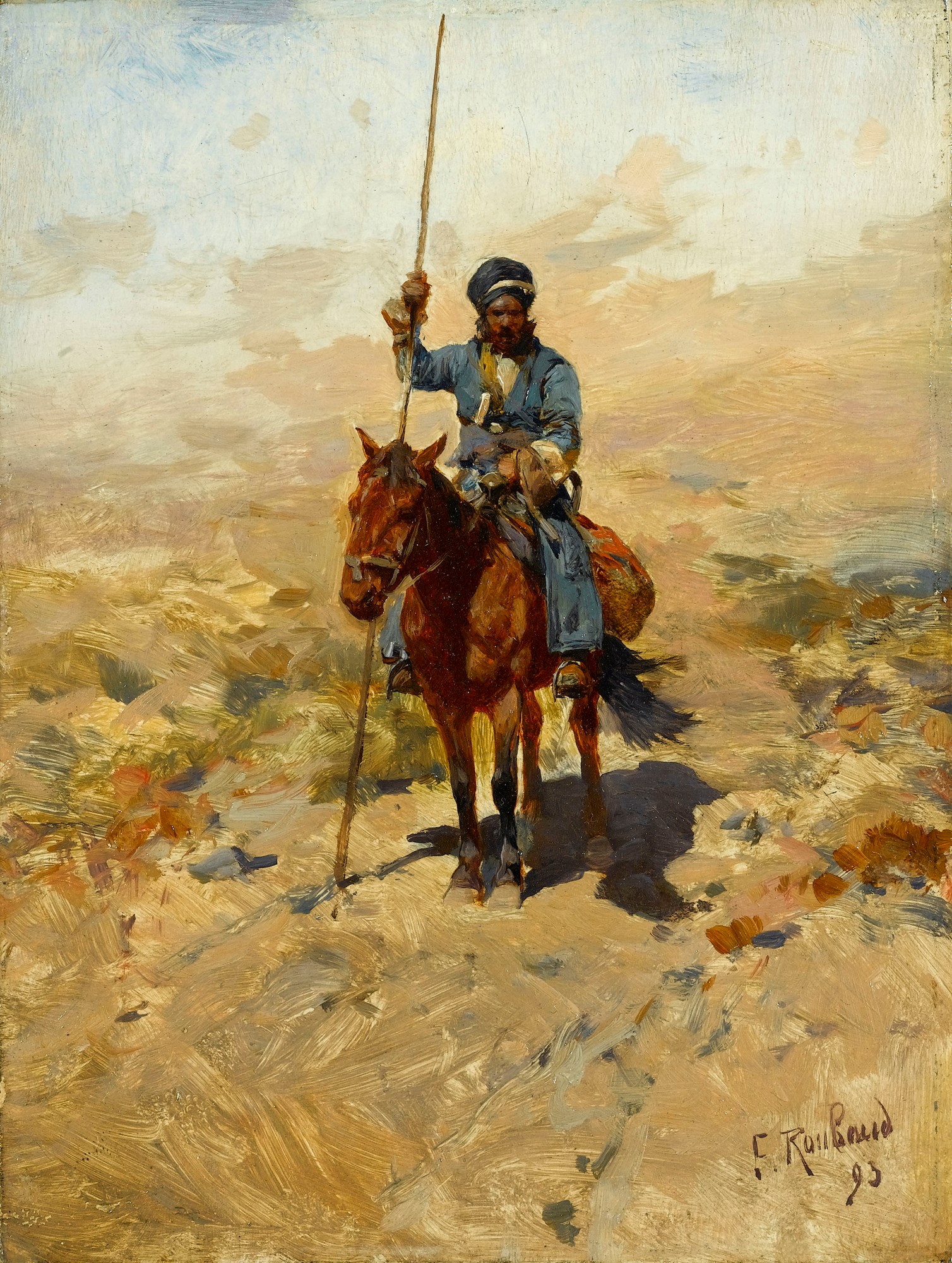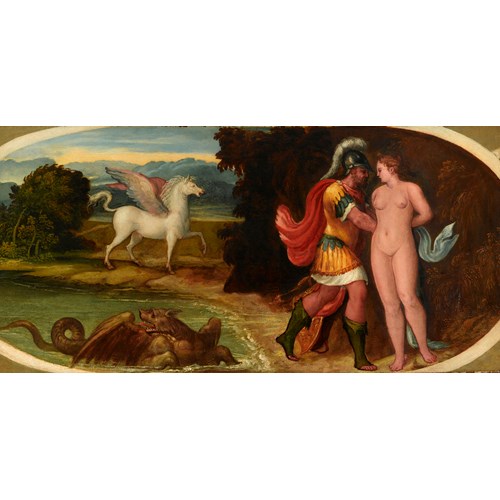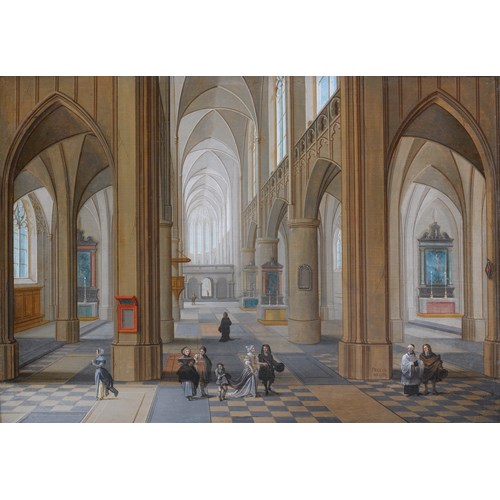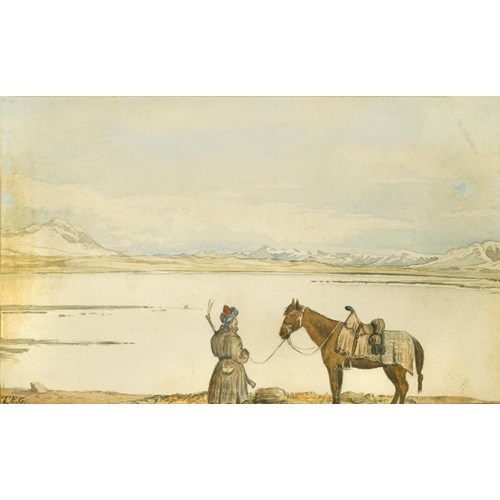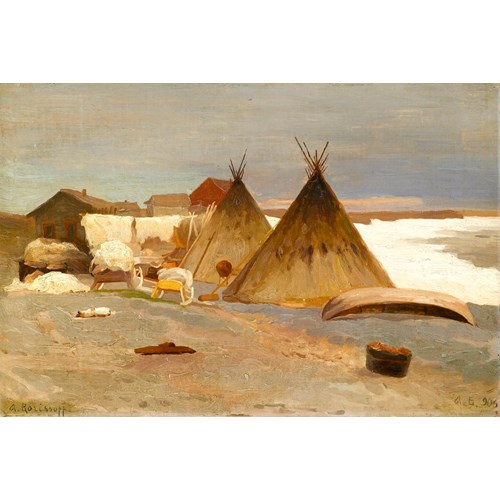Marketplace
Lone Cossack Horseman
Franz Alekseevich Roubaud
Lone Cossack Horseman
Date 1893
Period 1850-1900, 19th century
Origin Ukraine, Germany
Medium Oil on board
Dimension 18 x 13.5 cm (7¹/₈ x 5³/₈ inches)
This poignant and evocative painting shows a centrally positioned Cossack horseman facing directly towards the viewer, as if formally posing for his portrait. In his right hand he holds a long staff whilst he grips the reins of the horse with the other, a weapon tucked neatly into his tunic, showing a proud and commanding stance. Franz Alekseevich Roubaud chooses to focus entirely on the horseman and leaves the surrounding landscape unfinished with sketchy brushstrokes, whilst the features of the horse and rider are finer and more detailed. The weather-beaten face of the rider suggests a lifetime of hard commitment, while the horse appears weary, his head bowed in rest.
The rider wears a blue tunic with yellow shoulder straps, possibly identifying him as an Astrakhan Cossack. The Astrakhan Cossacks were established in 1750 to patrol the lower banks of the Volga from Astrakhan to Cherniy Yar. Ashtrakan lies on the Volga River in southern Russia, and the city is the administrative centre of Astrakhan Oblast, a federal subject or oblast of Russia. Astrakhan Cossacks such as the one in Lone Cossack Horseman took part in both the Patriotic War of 1812 and the Russo-Turkish conflicts throughout the nineteenth century. They were frequently portrayed in paintings, to epitomise the successes of Russian Imperialism on her closest frontiers.
The Cossack horses, though smaller than their regular cavalry counterparts, were frequently used by the regular cavalry due to their robustness. The saddle was attached to the horses back by two large girths, and the Cossacks’ possessions were stored in the saddle bag. However the harness had no bit, thereby allowing the horse to eat whenever it wanted to.
Roubaud was born in Odessa in 1856. At the age of twenty one he moved to Munich to study under the genre painter Carl von Piloty and Otto Seitz. In 1881, after having travelled to Paris and the South of France, Roubaud began his studies at a private school run by the famous Polish battle painter Josef von Brandt. Von Brandt particularly favoured historical Cossack subject matter and no doubt this made a lasting impression on the young Rubo.
Only two years later Roubaud received a commission from the Russian government to travel through the Caucasus and in 1885 he executed a series of history paintings for the Hall of Fame in Tiflis. It was during this period working in the Caucasus that Roubaud would have completed Lone Cossack Horseman. Besides monumental history paintings, Roubaud also produced a number of works depicting the people of the Caucasus region hunting, fighting and travelling. In 1913, he left Russia for Munich, where he died on 13th March, 1928.
The rider wears a blue tunic with yellow shoulder straps, possibly identifying him as an Astrakhan Cossack. The Astrakhan Cossacks were established in 1750 to patrol the lower banks of the Volga from Astrakhan to Cherniy Yar. Ashtrakan lies on the Volga River in southern Russia, and the city is the administrative centre of Astrakhan Oblast, a federal subject or oblast of Russia. Astrakhan Cossacks such as the one in Lone Cossack Horseman took part in both the Patriotic War of 1812 and the Russo-Turkish conflicts throughout the nineteenth century. They were frequently portrayed in paintings, to epitomise the successes of Russian Imperialism on her closest frontiers.
The Cossack horses, though smaller than their regular cavalry counterparts, were frequently used by the regular cavalry due to their robustness. The saddle was attached to the horses back by two large girths, and the Cossacks’ possessions were stored in the saddle bag. However the harness had no bit, thereby allowing the horse to eat whenever it wanted to.
Roubaud was born in Odessa in 1856. At the age of twenty one he moved to Munich to study under the genre painter Carl von Piloty and Otto Seitz. In 1881, after having travelled to Paris and the South of France, Roubaud began his studies at a private school run by the famous Polish battle painter Josef von Brandt. Von Brandt particularly favoured historical Cossack subject matter and no doubt this made a lasting impression on the young Rubo.
Only two years later Roubaud received a commission from the Russian government to travel through the Caucasus and in 1885 he executed a series of history paintings for the Hall of Fame in Tiflis. It was during this period working in the Caucasus that Roubaud would have completed Lone Cossack Horseman. Besides monumental history paintings, Roubaud also produced a number of works depicting the people of the Caucasus region hunting, fighting and travelling. In 1913, he left Russia for Munich, where he died on 13th March, 1928.
Date: 1893
Period: 1850-1900, 19th century
Origin: Ukraine, Germany
Medium: Oil on board
Signature: Signed and dated ‘F Roubaud/93’ (lower right).
Dimension: 18 x 13.5 cm (7¹/₈ x 5³/₈ inches)
Literature: E.Lingenauber and O.Sugrobova-Roth, Franz Roubaud. Catalogue raisonné, Dusseldorf: Edition Libertars, 2012, p.154, no.261 illustrated.
More artworks from the Gallery


